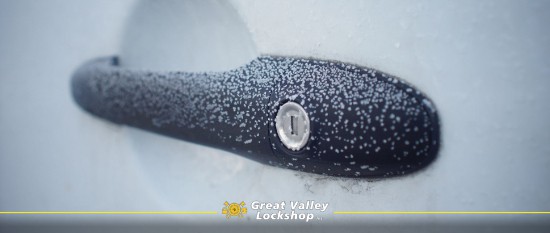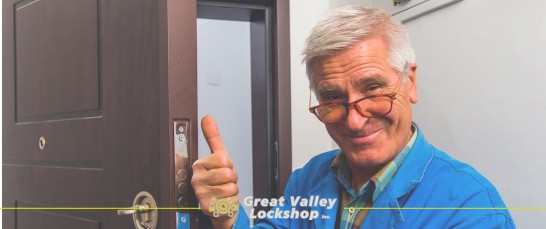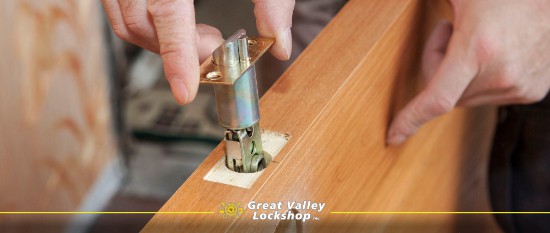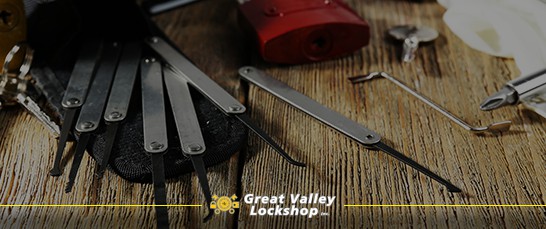
How to Unfreeze Your Door Lock
If you live in a northern state, like Pennsylvania, there’s no question that you’re already accustomed to the cold temperatures, snow and ice that the winter season brings with it. But winter brings other inconveniences – like poor driving conditions, ice dams, slush, and frozen locks.
There’s arguably nothing more frustrating than going to start your car in the morning only to realize that your door locks are frozen shut. Or maybe you arrive home in the evening to find your front door iced over and inaccessible.
Make Your Own Magic De-Icing Solution
This is a great trick that can be used on your door lock or car. To make your own fast-acting de-icing solution at home, you will need distilled white vinegar, an empty spray bottle and water.
The first step is to measure out 3 parts distilled white vinegar and 1 part tap water. Next, pour the measured amounts of vinegar and water into the empty spray bottle. Then, spray the solution on the frozen lock and wait 5 minutes. Finally, try to put the key in the lock. If there is still ice blocking the way, spray more solution on and allow another few minutes to melt the ice.
Methods for Thawing a Frozen Door Lock
So, just how do de-ice a frozen door lock on your home? Simply put, it’s all about bringing on the heat. Here’s what to do:
-
- Clear Ice from Around the Lock Cylinder – This essentially will clear a space for you to better insert the key, although the lock interior is still likely frozen. You can chip away ice from the lock cylinder opening by either using the tip of the key or a similar object – just be careful not to damage the lock itself.
- Heat the Key – We realize that this may be difficult to accomplish, depending on your situation. If you have access to hot water, de-icing chemicals, hair dryer, heat gun, or blowtorch, these tools should be your first approach. As an alternative, you could use matches or a lighter.
- De-Ice the Keyhole – The best option is to use a de-icing spray to target the keyhole of the lock If you have access to a lubricant spray, such as WD40, this can also be used to clear some of the ice from inside the lock cylinder through the keyhole.
Watch this video to see how greasing the keyhole can quickly fix a frozen lock problem.
If you’re able to start your car, you could place the key on the radiator to warm it up. Either way you heat the key, be sure to use gloves when handling the hot key. Then just insert it into the lock and at least the first layer of excess ice should melt away immediately.
How to Prevent House Locks from Freezing
By following the above steps, it’s possible to unfreeze a lock, but there are also several preventative measures that you can take. Here’s what you can do before the first freeze to ensure that locks are better equipped to handle freezing temperatures.
Moisture tends to work its way into locks while the outdoor temperatures are still warm. Then, when cold weather sets in, this moisture can freeze within the lock. To prevent frozen locks, you can oil them before the first frost of the year. Oiling the locks will put a thin, protective layer over the lock’s inner mechanical parts, whisking moisture away and ensure that moving parts are operating well even in the cold.
Related article: How Changes in Temperature Affect Locks.
What Not to Do When De-icing Car Door Locks
Don’t panic, first and foremost. Your initial instinct may be to pour hot water on the lock or try to chip away at the ice. These are no-no’s and can cause serious damage to your vehicle. Pouring water in the lock can cause water to get inside the door frame and freeze again or it can result in thermal shock that shorts out modern electronics such as sensor and lock cylinders. Chipping at ice on door locks can be tricky, and this process may result in breaking dinging your car and chipping paint away, too.
What to Do if Your Car Door Lock is Frozen
Car door locks aren’t usually as difficult to resolve then home door locks. This is simply because you are more likely to have access to tools and products that can help melt the ice in and around the lock.
Here are some tips and suggestions on how to solve the situation so you can be on your way:
-
- Try another Door – This may seem like an obvious solution, but it’s amazing how often it is overlooked. The problem may have been caused by the fact that one side of the car is exposed to more shadow while the other is exposed to more sunshine, decreasing the likelihood that the other side may freeze. Once you’ve gotten inside, the warm air inside the car will aid the frozen door to defrost, so start the engine and turn on the fans.
- Start the Engine – Often, only one side’s door locks will freeze up, especially if one side of the car is facing the sun. Try to gain access through another door or a hatchback so you can get inside and crank the engine. This alone may be enough to warm the frozen lock within a few minutes, so you can get on your way quickly.
- Try Pushing the Handle, Instead of Pulling – If the door is frozen shut, moving the door in any direction will help crack the ice frozen there. So, if pulling doesn’t work, place your hand flat on the card door and give it a firm push. This is actually preferable because it won’t damage the handle or the seal around the door.
- Use Hand Sanitizer or WD-40 – If you find a car door lock is frozen, dab a bit of hand sanitizer on your key stem and gently maneuver it into the frozen lock. These alcohol-based sanitizers will often burn through the ice in car door locks rather quickly, so you get moving again. However, there is another home item that can serve as a preventive measure for ice forming in locks—good old WD-40. If you just take a moment to spray a dab on the door lock each night, this wonderful solution can winterize your auto by keeping internal condensation from actually freezing.
- Spray De-icing Formula – If you live in a northern state, chances are that you stock up on a few cans of de-icer during the winter months for situations like this. Spraying de-icer directly into the lock will quickly melt any ice around it.
- Park in the Sunlight – If you don’t have a garage to park within, consider which direction the sun rises in, and try to strategically park with the driver’s side door facing that direction so it receives direct sunlight first thing in the morning. More than a solution, this is a preventive measure that can help stave off those pesky frozen car door locks.
- Heat the Lock – If the first two means don’t work, a last-ditch resort is a hair dryer. You will need an extension cord long enough to stretch from your home or an external electrical outlet, all the way to your car’s door lock. Once you get the hair dryer operational, block the wind with your body to ensure that the iced over door lock gets the maximum amount of heat for fast melting action.
- Heat the Key – Heating the key when your car’s door is iced over can help free the lock. You can do this with either matches or a lighter or you can boil a pot of water with the key in it to get it nice and hot. Be safe, and use oven mitts, tongs, and winter gloves when appropriate throughout the process.
Watch this video for an easy step-by-step demonstration of how to fix a frozen car lock.
Beware of the Risks that Come with DIY De-Icing Methods
Regardless of whether it’s your home or your car door lock that’s been iced over, there are DIY options to resolve the situation – and with little inconvenience. However, it’s worth noting that all these DIY options also come with risk.
For instance, heating your key to melt away ice could be dangerous if you’re not protecting yourself properly. And attempting to chip away ice covering the lock could damage the lock in the process, leaving you with one more problem to solve. More extreme measures like using a blowtorch could damage the lock or the paint job.
Always keep safety in mind and use extra caution when attempting to open a frozen door lock yourself.
You can reach Great Valley Lockshop at (610) 644-5334 or fill out our form to schedule locksmith services.
Editor’s Note: This post was originally published in February 2015 and has been updated for accuracy and comprehensiveness.








